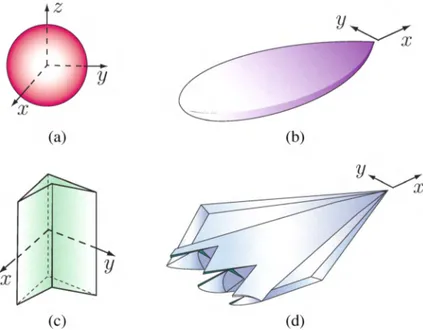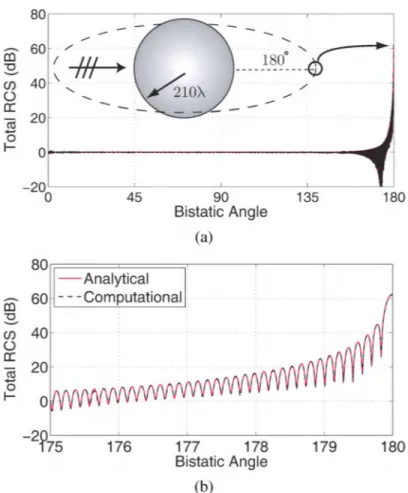Solutions of Electromagnetics Problems Involving Hundreds of Millions of Unknowns with Parallel Multilevel Fast Multipole Algorithm
t
Ozgiir Ergiil1,2 and Levent Giirel1,2*
1Department of Electrical and Electronics Engineering 2Computational Electromagnetics Research Center (BiLCEM)
Bilkent University, TR-06800, Bilkent, Ankara, Turkey {ergul,lgurel} @ee.bilkent.edu.tr
Introduction
We present the solution of extremely large electromagnetics problems formulated with surface integral equations (SIEs) and discretized with hundreds of millions of unknowns. Scattering and radiation problems involving three-dimensional closed metallic objects are formulated rigorously by using the combined-field integral equation (CFIE). Surfaces are discretized with small triangles, on which the Rao-Wilton-Glisson (RWG) functions are defined to expand the induced electric current and to test the boundary conditions for the tangential electric and magnetic fields. Discretizations of large objects with dimensions of hundreds of wavelengths lead to dense matrix equations with hundreds of millions of unknowns. Solutions are performed iteratively, where the matrix-vector multiplications are performed efficiently by using the multilevel fast multipole algorithm (MLFMA) [1]. Solutions are also parallelized on a cluster of computers using a hierarchical partitioning strategy [2], which is well suited for the multilevel structure of MLFMA. Accuracy and efficiency of the implementation are demonstrated on electromagnetic problems involving as many as 205 million unknowns, which are the largest integral-equation problems ever solved in the literature.
Multilevel Fast Multipole Algorithm
MLFMA reduces the complexity of the matrix-vector multiplications required by iterative solvers from 0(N2 ) toO(NlogN). A tree structure is constructed by placing the object in a cubic box and recursively dividing the computational domain into subboxes (clusters). Interactions between the clusters are calculated by translating the radiated fields of the clus-ters into incoming fields to other clusclus-ters. Without losing generality, consider a smooth object with an electrical dimension of kD, where k = 21r/Ais the wavenumber. Dis-cretization (triangulation) of the object with A/I0mesh size leads toN unknowns, where N = 0(k2D2 ). A multilevel tree structure withL = O(logN) levels is obtained by
con-sidering nonempty boxes, i.e., clusters. At level lfrom 1 toL, the number of clusters can be approximated as Nz ~ 4(1-l)Nl ,whereNl = O(N). In order the calculate the
inter-actions between the clusters, radiated and incoming fields are defined and sampled on the unit sphere. The sampling rate depends on the cluster size as measured by the wavelength, and the total number of samples per cluster can be approximated as Sz ~ 4(l-1)SI,where SI = 0(1). We note that the complexity at levell is proportional to the product of the number of clusters and the number of samples, i.e., NzSz ~ NISI = O(N). Hence, all levels of MLFMA have equal importance with O(N) complexity in terms of processing time and memory.
tThis work was supported by the Scientific and Technical Research Council of Turkey (TUBITAK) under Research Grants l05E172 and l07E136, by the Turkish Academy of Sciences in the framework of the Young Scientist Award Program (LG/TUBA-GEBIP/2002-1-12), and by contracts from ASELSAN and SSM.
Hierarchical Parallelization of MLFMA
For the solution of very large problems, MLFMA running on a single processor may not be sufficient, and parallelization is required. Unfortunately, MLFMA involves a complicated tree structure, which is difficult to distribute among multiple processors. Lower levels of the tree structure involve large numbers of clusters with coarsely-sampled radiated and incom-ing fields, while the higher levels involve small numbers of clusters with fine samplincom-ings. Recently, we developed a hierarchical partitioning strategy, which is based on distributing both clusters and field samples at each level by considering the numbers of clusters and samples [2]. This strategy improves the parallelization efficiency, compared to previous parallelization approaches that are based on distributing either clusters or field samples at a level.
Consider the parallelization of MLFMA on a cluster ofpprocessors, wherep = 2i for some
integer i. Using the hierarchical partitioning strategy, the number of partitions for clusters at levell is chosen as
_ {_p }_
{(I-l)}
PI,c- max 2(1-1),1 -max p2 ,1.
Then, the number of clusters assigned to each processor can be approximated as
In addition, samples of the fields are divided into
PI,s =
L
= min{2(1-l),p} PZ,c(1)
(2)
(3)
partitions along the () direction for levell. For each cluster, the total number of samples per processor can be written as
(4)
By distributing both clusters and field samples, the hierarchical strategy improves the load-balancing of the workload among processors. In addition, the communication time is sig-nificantly reduced compared to the previous parallelization strategies.
Numerical Results
The improved efficiency provided by the hierarchical strategy was demonstrated on rela-tively small problems involving millions of unknowns solved on 2 to 128 processors [2]. In this study, we use the hierarchical parallelization of MLFMA for the solution of very large electromagnetics problems. As an example, we present the solution of scattering problems involving various metallic objects depicted in Fig. 1. These are (a) a sphere of radius 180'\, (b) the NASA Almond of length 715'\, (b) a 400,\ long wing-shaped object with sharp edges and comers, and (d) the stealth airborne target Flamme with a maximum dimension of 720'\. All objects are discretized with ,\/10 triangles, leading to matrix equa-tions with more than 100 million unknowns. Iterative soluequa-tions are performed by using the biconjugate-gradient-stabilized (BiCGStab) algorithm accelerated via MLFMA with two
(a)
(c)
(b)
(d)
Fig. 1. Examples to metallic objects considered in this study: (a) Sphere, (b) NASA Al-mond, (c) wing-shaped object, and (d) Flamme.
Table 1: Solutions of Large-Scale Scattering Problems
16 Processors 64 Processors BiCGStab Time Memory Time Memory Problem Size Unknowns Iterations (minutes) (GB) (minutes) (GB)
Sphere 360-X 135,164,928 23 975 424 292 467 Wing 400-X 121,896,960 17 546 431 162 500 Almond 715-X 125,167,104 20 769 385 215 471 Flamme 720-X 134,741,760 44 1186 427 345 513 digits of accuracy. Convergence of the iterative solutions are also accelerated by using block-diagonal preconditioners. Solutions are performed on a parallel cluster, which con-sists of 16 computing nodes. Each node involves 3.0 GHz Intel Xeon processors and a total of 32 GB memory. We parallelize the solutions into 16 and 64 processes by employing 1 and 4 processors per node. Table I lists the number of iterations (for10-3residual error),
peak memory, and the total processing time including setup and solution parts. Using 64 processors, the parallelization efficiency for both processing time and memory is more than 80% with respect to 16 processors. Due to this relatively high efficiency provided by the hierarchical partitioning strategy, we are able to perform all four solutions in Table I in 1014 minutes, which is less than 17 hours.
Efficient solutions of the large problems presented in Table I are obtained under strict con-ditions in terms of accuracy. We note that larger problems could be solved by sacrificing the accuracy. Solutions can be relaxed by using coarser discretizations, reducing the truncation numbers, or decreasing the order of interpolations. The size of the problems can also be enlarged at the cost of increasing processing time. For example, we calculate and store radi-ation and receiving patterns of basis and testing functions during the setup of the program, and we use them efficiently during iterations. Calculating the patterns on the fly in each matrix-vector multiplication without storing them would increase the processing time, but
larger problems could be solved. In general, we do not follow these tricks since the major purpose of this study is solving very large electromagnetics problems fast and accurately. Finally, to demonstrate the accuracy of the solutions, Fig. 2 presents bistatic radar cross sec-tion (RCS) values for a sphere of radius 210'\. In Fig. (a), the normalized RCS(RCS/1ra2 ,
whereais the radius of the sphere in meters) is plotted in decibels (dB), where 00 and 1800
correspond to the back-scattering and forward-scattering directions, respectively. Com-putational values obtained by solving a 204,823,296-unknown matrix equation are com-pared with the analytical values obtained by a Mie-series solution. For an easy comparison, Fig. (b) presents the same results from 1750 and 1800
• We observe that the computational
and analytical results perfectly agree with each other.
... ~'~• . . . . 1800 ---20 90 135 180 0 45 Bistatic Angle (a)
80
- Analyticalco
60
- - -Computational ~en
40
()a:
(ij...
20
0 I-0
-2~75
176
177
178
179
180
Bistatic Angle (b)m
60 /' -0 IIII
~-u;
40 \ Iff ... ()'
... a: Cl3 20 ...o I- O~---r-j 80r---....---.---r---.Fig. 2. Bistatic RCS (in dB) of a sphere of radius 210,\ (a) from 00 to 1800 and (b) from
1750 to 1800
, where 1800 corresponds to the forward-scattering direction.
References
[1] J. Song, C.-C. Lu, and W. C. Chew, "Multilevel fast multipole algorithm for elec-tromagnetic scattering by large complex objects," IEEE Trans. Antennas Propagat., vol. 45, no. 10, pp. 1488-1493, Oct. 1997.
[2]

